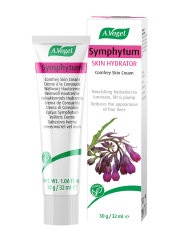The benefits of comfrey
Scientists have recently discovered that a compound found in the common comfrey plant can help to keep skin youthful and less susceptible to the formation of wrinkles.
Symphytum officinale, aka common comfrey, is native to Europe and tends to grow fairly unnoticed. This purple plant thrives in damp, grassy places near farmyards, in ditches and by riverbanks. It isn’t surprising then that comfrey is widespread throughout the British Isles.
What is surprising is that this seemingly dull plant can actually benefit your skin more than you thought any humble plant ever could.
The comfrey plant contains several beneficial compounds which help to revive tired, aged, wrinkled skin.
“Symphytum, when used regularly on the skin, makes it softer, more supple and elastic. Even skin with large pores can benefit from it… This care is of such benefit to the skin that even wrinkles can be prevented from forming early in life.” – A.Vogel
Recent research conducted by the University of Liverpool has confirmed that there are anti-aging properties found within comfrey which they hope to discover hold ‘longer-life’ effects.
These properties are thought to be a result of a compound known as allantoin, which is found within the root mucilage* that comfrey produces.
* A thick substance produced by all plants
The secret inside comfrey that benefits your skin
Allantoin is the key to beautiful, younger looking skin due to its ability to perform skincare wonders....
Reduces inflammation: the compound allantoin is viewed in the medicinal world as valuable. It is already used in many creams to help treat painful skin conditions, such as nappy rash, wind burn, scrapes and cuts; this is due to its anti-inflammatory properties.
Softens: allantoin also acts as an emollient. This is a moisturising treatment that helps to develop a protective film over the skin cells, reducing water loss.
Acts as a keratinolytic: in skin care products, allantoin helps to moisturise and soften skin and acts as a keratinolytic.
Keratinolytics soften keratin, a tough, inflexible protein found in the outer layer of the skin. By softening keratin, allantoin allows the skin to hold onto water better. This makes it moister, softer, and better hydrated. Keratinolytics also allow the outermost layer of skin cells to shed more easily, creating a smoother, moisturised and improved.
Keratinolytics also allow the outermost layer of skin cells to shed more easily, creating a smoother, moisturised and improved texture of skin.
Other beneficial compounds found in the comfrey plant include:
Tannins: are the defensive compounds that protect the plant. They and can also protect our skin from bacteria and environmental toxins by drawing out impurities and encouraging healing.
Rosmarinic acid: has antioxidant effects and helps to protect the skin from UV damage.
A brief history of comfrey
The comfrey plant has been used for medicinal purposes for over 2000 years. The earliest recorded use of comfrey as a traditional, herbal remedy can be traced back to the ancient Greeks in 400BC.
Comfrey was traditionally used to help mend broken bones. In fact, the name comfrey comes from the Latin word Confervere which means ‘to join together, to mend or to heal’.
The regenerative compounds found in comfrey, such as allantoin, tannis and rosmarinic acid, help to speed up the natural replacement of cells and encourage new tissue growth.
Ensuring the skin is kept hydrated is of utmost importance when fighting the signs of aging, as hydration helps to plump the skin and leaves a dewy glow.
Nature facts about comfrey
- Comfrey is herbaceous plant that belongs to the borage family.
- The flowering time for comfrey is May to June.
- Certain species of comfrey have cold-resistant bacteria, so can thrive and live in freezing temperatures.
- There are around 25 species of comfrey that are native to Europe and Asia.
- Cultivation of comfrey started 2,500 years ago.
In a nutshell
Overall, comfrey is beneficial to all skin types; it helps to moisturise and soothe dry irritated skin, promotes rapid skin-cell growth, contributes to skin renewal, protects against bacteria and other microorganisms, reduces inflammation and helps to keep skin healthy.
Use comfrey moisturiser
Most skincare creams do contain a little allantoin. A lot of cosmetic companies, however, use dried herbs and plants as a cheaper method to making skin creams.
A rich, nourishing cream that gives life to tired, dry, ageing skin
A.Vogel Comfrey Cream uses only freshly harvested cuttings of comfrey from our farms in Roggwil. This guarantees that all of the ingredients are at their most active, making for more powerful and faster results.
This nourishing formula can be used at night to help fight the appearance of fine lines and wrinkles, and throughout the day for additional support to banish dull, toneless skin.
Alkaloids
Comfrey is recommended for external use and is very beneficial for skincare products.
However, studies have shown that comfrey is not safe to be taken for internal use as the plant contains pyrrolizidine alkaloids, which are toxic to the liver. A.Vogel Comfrey Cream is safe to use externally.
Our comfrey has been tested on willing participants, never animals, and is safe to use on your skin to combat wrinkles.
Did you already know about the benefits comfrey brings? Are there any other plants you would like to be investigated? Leave your comments below.








